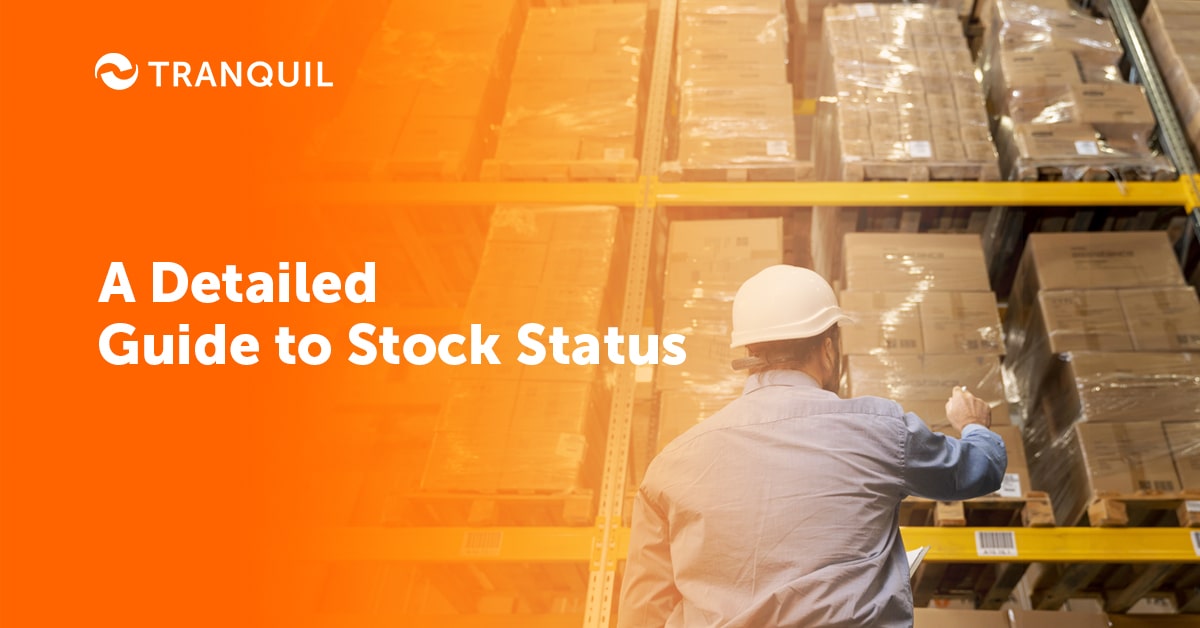
A Detailed Guide to Stock Status
Stock usually refers to the finished products a business has for sale – for example, shirts –, while inventory means both the finished goods and the raw materials required to produce goods – like fabric, thread, buttons, etc.
However, many businesses use both terms interchangeably – especially when they are not manufacturing.
Stock status in inventory management refers to how much of a product is available for sale.
Additionally, it tracks which products are low in stock and need to be ordered, and various other things related to stock.
It is an invaluable tool that helps to monitor stock levels and track inventory.
ALSO READ: Advantages of ERP to Automotive Businesses
Stock Status – Definition
Stock status is a report of the stock in hand, what has to be shipped to customers, and what is in transit, to be received.
The main element is about knowing how much stock of a given product is available to sell.
Stock levels are tracked to make sure that a business has sufficient products in hand to fulfil consumer demand.
It also helps ensure that there isn’t excess stock to the extent that it blocks a big chunk of your working capital.
Stock status can be measured in a number of units or monetary terms, or both.
There are several ways to measure the product stock status, but Days in Supply, DoS is the most popular method today.
It considers the number of days for which a company has sufficient stocks to fulfil consumer demand before running out.
A simple way to arrive at this figure is to divide the stock units by the average per-day sales volume.
ALSO READ: A Detailed Guide on Stock Adjustment and Stock Transfer
What is the Stock Status Report?
The stock status report offers information about the inventory levels for a specific product or for a set of products.
This aids in proper stock management, and making sure that you have adequate goods to ship to customers rather than getting stocked out and disappointing them.
A stock status report includes detailed data on various factors like reorder points, future demand forecasts, and so on, in addition to the stock level at present.
ALSO READ: Key Steps for Successful Demand Planning
What Does the Inventory Stock Status Report Include?

- On hand – the quantity of goods available for sale
- Hand outed – quantity of goods for which there is demand but no ready availability
- Not available – products that are unavailable at present
- Made to order – quantity of products available within a week based on orders received
- Ready to ship – product quantity available for shipping
- Discontinued – the products that won’t be manufactured once the current stock finishes
- Temporarily unavailable – products unavailable as of now, but for which backorders will be taken when they become available
- Sold out stock – the quantity of products already sold due to customer demand
ALSO READ: What is Stock Taking?
Inventory Reports that Help in Determining Stock Status
1. Inventory on Hand
If you keep getting stocked out, you will lose customers to the competition.
Hence, it is critical that you know what products sell fast and get stocked out.
However, if you have products in your inventory for long periods, it means they are not selling quickly.
This feature will display detailed overviews of stocks including product variants in your store or warehouse.
ALSO READ: Benefits of ERP in Production Planning
2. Low Inventory

This is a list of products that are low in stock as per the reorder points as defined for those products.
Products whose stocks are above this level, or don’t have predefined minimum levels set, won’t be included in this report.
Studying this report regularly will help you identify patterns regarding products that keep running low.
You can take the decision to increase the order quantities of such products that always appear here.
3. Inventory Aging Report
This shows the number of days you are holding a particular stock and its quantity.
Knowing how much inventory is there on hand and for what period is critical as it helps to identify items that are selling slow or not at all, for how long the product remains in inventory and the cost of keeping that inventory for long periods.
This will tell you what products consumers are buying and what they are not – and you will know which products to stock.
ALSO READ: Benefits of E-commerce and ERP Integration
4. Turnover Inventory
This report helps in assessing your inventory turnover each year; a high turnover rate means that items is selling fast and you need to stock more of it.
Low turnover means that the product is selling slowly and hence is overstocked, and should be ordered less.
It helps you to adjust your strategies with regard to pricing, reordering, and sales.
5. Inventory Performance Report

In this report you can see which products are your best sellers, and which move the slowest; you can also see the growth year over year.
Knowing which products sell well and which don’t help to understand how much you need to reorder.
The year-over-year growth tells you about the financial performance of your company – whether there is improvement, no change, or decline.
This helps you to make the requisite alterations in your supply chain.
ALSO READ: Why is Cycle Stock Important for Your Business?
6. Inventory Profitability Report
There are three types of inventory profitability – listing, SKU, and trending.
The SKU profitability is an indicator of the actual profit of each SKU.
The listing profitability is about the SKU performance data as per gross as well as unit margins and according to sales of each channel.
Trending reports display the profitability over a certain time period.
These product analytics can help you to avoid the dead stock, reduce expenses, and boost profitability by pushing fast-selling products.
7. Inventory Value Report
Inventory analytics play an important role in purchase strategy, and help you manage cash flows effectively.
An inventory value report illustrates the complete value of all the products and can show volume comparison in the case of multiple warehouses.
This data can be broken down for each product.
This report also picks out individual product performance according to its value, age, and inventory turnover ratio.
ALSO READ: Benefits Of ERP Software For Logistics Industry
8. Stock Levels Report
This report has a dual advantage as it can monitor critical levels and also help define reorder levels.
Critical levels show the speed of sales and the approximate date the stock will likely finish; replenishment alerts provide a list of the stocks that need to be replenished.
All these factors impact purchase decisions.
They can therefore help protect your revenue stream, and enhance profitability.
9. Inventory Forecasting Report

This report aims at determining how much inventory would be required to fulfil consumer orders in the future; this depends on the quantity of products the business expects to sell in a specific time period.
Planned marketing campaigns, historical sales data, and known external factors are considered to arrive at precise forecasts.
ALSO READ: Why ERP User Interfaces are Important?
10. Sales Report
A comprehensive sales report can help you optimize your accounts process and give in-depth visibility into your cash flows.
You can have accounting summaries for individual sales platforms, including taxes, refunds, and discounts in addition to incomes.
You can also generate reports for set time periods and product categories, and discover sales trends.
It will help in identifying your best customers and making your forecasting better.
Benefits of Stock Status

1. Long-Term Planning
The biggest advantage of stock status is being able to plan and define goals for the long term.
You have an edge over the competition as you are better placed to plan for festivals and other upcoming events in the future and ensure that you have adequate stock in hand.
2. Improved Sales
Stock status reports help you identify business trends and realize where you need to improve.
By monitoring business trends and evaluating your performance, you can make adjustments to boost your sales.
ALSO READ: Ultimate Guide to Dropshipping
3. Well-defined Objectives
Stock status helps you to define organizational goals clearly.
You know the quantity you have ordered and what is utilized, damaged, or wasted.
This information will help you to make better purchase order decisions.
4. Fewer Stock Issues
Understocking and overstocking are common inventory problems that can prove disastrous for your business.
Buying products to sell or raw materials for production entails investing a good sum of money.
When you purchase more than what you can sell, you have an overstocking issue, tying up funds and suffering losses. When you purchase too little, you end up disappointing your customers and losing business.
To boost revenues, you must avoid being stocked out as well.
However, these issues can be easily avoided if you maintain proper records.
A thorough inspection of historical records will help you determine your average sales and purchases.
Be sure that your data is, accurate – without that you cannot have reliable inventory reports and you will not get the outcomes you desire.
ALSO READ: Difference Between Procurement And Purchasing
How Can You Generate Inventory Reports?

Inventory reports can be easily generated with the help of inventory management software.
With this tool, you can have error-free, reliable data and fast-track your business growth.
It is much easier and quicker than manual reporting.
Inventory management software from Tranquil can help you generate various kinds of reports almost instantly, which helps you to make informed business decisions.
Inventory management software offers numerous benefits.
It provides real-time information of your inventory, tracing it effectively.
It can pinpoint the location of the inventory and send alerts when the product has to be reordered.
In some instances, you will be able to configure the system to automatically send orders to handpicked vendors, when the inventory reaches a certain level.
ALSO READ: What is Business Process Improvement (BPI)?
Conclusion
We have seen how stock status reports give in-depth information about stocks of various products.
This helps businesses to ensure optimal inventory – neither too much nor too little, but enough to fulfil customer demands and not get stocked out.
The report includes several things like reordering levels, the stock level at present, and demand forecast for the near future, and can also include data about backlogs of orders placed by customers.
ALSO READ: A Detailed Guide to Batch Tracking
Consequentially, stock status reports help businesses to manage their inventory levels better, accelerate production to match consumer demands, and to maintain optimal stock in hand to serve customers better.
A stock status report is an invaluable tool for businesses that want to achieve optimal inventory management.
With the knowledge of inventory levels at present and future demand forecasts, businesses can make data-driven decisions regarding production and evade possible supply chain disruptions.
Make the right decision for your business and streamline your inventory management with a robust ERP like Tranquil. It’s a cloud-based ERP system that is intuitive, feature-rich, and scalable. It is flexible, and can also be tweaked to suit your unique business requirements. Schedule a demo with us to know more. Our executives will take you through the software and will be happy to answer your queries.



